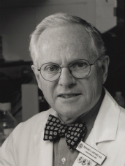Two cytodifferentiation agent-induced pathways, differentiation and apoptosis, are distinguished by the expression of human papillomavirus 16 E7 in human bladder carcinoma cells Journal Article
| Authors: | Richon, V. M.; Russo, P.; Venta-Perez, G.; Cordon-Cardo, C.; Rifkind, R. A.; Marks, P. A. |
| Article Title: | Two cytodifferentiation agent-induced pathways, differentiation and apoptosis, are distinguished by the expression of human papillomavirus 16 E7 in human bladder carcinoma cells |
| Abstract: | Many transformed cells have been found to lose the capacity to proliferate and undergo differentiation following exposure to hybrid polar agents. This study investigates the mechanism by which hexamethylene bisacetamide (HMBA) suppresses the proliferation of the human bladder carcinoma line, T24. We found that following a 24-H exposure to HMBA, T24 proliferation was inhibited, and cells arrested in G1 phase and underwent morphological maturation. HMBA-Induced cessation of proliferation was mediated, in part, by effects on cell cycle regulatory proteins. In T24 cells cultured without HMBA, E2F complexes predominantly with p107. In culture with inducer, p107 protein decreased, pRB and p130 were converted to underphosphorylated forms, and E2F was shifted into complexes with pRB and p130. To determine whether the formation of pRB: E2F and p130:E2F complexes was required for the HMBA-Induced G1 arrest, the ability of the pocket proteins to bind E2F was blocked by enforced expression of human papillomavirus 16 E7. Following culture with HMBA, the T24 clones expressing E7 died, whereas vector-Alone T24 clones arrested in G1 phase. T24/E7-1 cells did not form pRB:E2F or p130:E2F complexes upon culture with HMBA; rather, E2F was present in its free form. T24/E7-1 cells cultured with HMBA initially accumulate in G1. By day 2, they have entered into S phase, and by day 3, over 80% of the cells became apoptotic. Taken together, these studies enlarge the repertoire of demonstrated developmental pathways that may be triggered in transformed cells, depending upon their molecular status, and may provide potential therapeutic opportunities for cancer. |
| Keywords: | immunohistochemistry; controlled study; protein phosphorylation; human cell; dna-binding proteins; antineoplastic agents; proteins; cell cycle proteins; cell cycle s phase; cell division; apoptosis; protein binding; cell differentiation; tumor cells, cultured; transfection; urinary bladder neoplasms; transcription factors; nuclear proteins; cell transformation; carrier proteins; immunoblotting; phosphoproteins; cell size; carcinoma, transitional cell; bladder carcinoma; actins; retinoblastoma protein; cell cycle g1 phase; g1 phase; retinoblastoma-like protein p107; retinoblastoma-like protein p130; regulator protein; virus expression; papilloma virus; growth inhibitors; transcription factor dp1; oncogene proteins, viral; hexamethylenebisacetamide; e2f transcription factors; acetamides; humans; human; priority journal; article |
| Journal Title: | Cancer Research |
| Volume: | 57 |
| Issue: | 13 |
| ISSN: | 0008-5472 |
| Publisher: | American Association for Cancer Research |
| Date Published: | 1997-07-01 |
| Start Page: | 2789 |
| End Page: | 2798 |
| Language: | English |
| PUBMED: | 9205091 |
| PROVIDER: | scopus |
| DOI/URL: | |
| Notes: | Article -- Export Date: 17 March 2017 -- Source: Scopus |
Citation Impact
MSK Authors
-
 91
91Richon -
 583
583Russo -
 612
612Cordon-Cardo -
 23
23Venta-Perez -
 186
186Marks -
 118
118Rifkind
Related MSK Work


